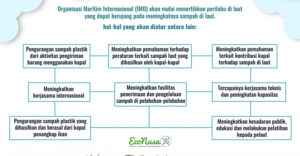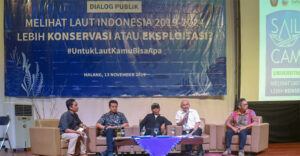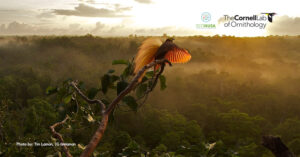
Eduard De Vogel, Charlie Danny Heatubun, Daawia Suhasiswa and Eline Hoogendijk infiltrated the primary forest in the Senggi District, Keerom Regency, Papua Province. That day, the second week of February 2018, became one of their lucky days as scientists.
Despite the first observation, Ed’s gaze – greeting Eduard – and his colleagues have been spoiled by the many orchids they have met. They have succeeded in collecting hundreds of orchids from tree trunks that have been cut down by the community. In the name of conservation, they do not want to cut down other tree trunks.
Goddess Fortuna hasn’t moved. Another fortune occurred when they found the orchid Bulbophyllum flowering. Flower characteristics are the key to answering the question whether or not Bulbophyllum is a new species.
They are rarely found in blooming orchids. Usually, of the many orchids they meet, only 10 percent of orchid petals bloom. This time, Bulbophyllum flowers reach 8 centimeters.
“We were very happy when we found an orchid (Bulbophyllum). I hold with both hands when transferring, “Ed said during the series of events at the International Conference on Biodiversity, Ecotourism, and Creative Economy or ICBE 2018, Manokwari, West Papua.
At first glance, Ed suspected Bulbophyllum was a new species. To prove his suspicions, Ed opened the orchidsnewguinea.com page, a site that collects information about orchids in New Guinea; plains which are the land of Papua (Papua and West Papua) and Papua New Guinea. The web page was created with André Schuiteman, Royal Botanic Garden Kew scientist, England.
They immortalize the shape of Bulbophyllum into the camera lens. It takes several days to ensure the Bulbophyllum orchid is a new species. Eline was in charge of making pictures of Bulbophyllum for scientific publications.
Pay homage to Iriana Jokowi
Ed has paid tribute to many people to capture their names in the name of the orchid taxonomy. He has put the names of cosmetics entrepreneurs and herbalists Martha Tilaar, Ratu Maxima, Queen Beatrix and ambassadors who are credited with preserving biodiversity, behind the genus Bulbophyllum.
This time, the four researchers agreed to pay tribute to those who contributed to the Land of Papua: First Lady Iriana Joko Widodo. Thus, Iriana has two names that are embedded behind the name of the orchid genus.
In July 2015, the Singapore government placed the name Iriana Jokowi behind the genus Dendrobium. Dendrobium iriana jokowi is a symbol of respect for Jokowi’s and Iriana’s visit to the National Orchid Park.
“He did a lot for development in Papua, supporting development initiatives, recognizing this (ICBE) conference. Unfortunately he (Iriana) could not attend, “said Ed.
The results of Ed’s research and his colleagues were published in the journal Journal Journal Volume 6 on October 5, 2018, two days before the opening of ICBE. In the same journal there is also a description of the Bulbophyllum adolinae orchid, a tribute to Juliana Adolina Kiriwenno Mandacan, wife of West Papua Governor Dominggu Mandacan.
President Jokowi is scheduled to attend the opening of ICBE 2018. According to Daawia, Eline and Ed have prepared a picture frame of B. irianae that they brought from the Netherlands. This time they were unlucky. Jokowi and Iriana flew to Medan, North Sumatra, opening the XXVII National Musabaqah Tilawatil Quran (MTQN).
Another option, they want to visit Iriana directly to Jakarta. Before coming to the State Palace, Daawia said she wanted to collaborate with PT Pos Indonesia.
“We have a plan to print pictures (Bulbophyllum irianae) on stamps and signed (by Iriana). Maybe Eline gave it because she drew it. We want B. irianae to be known to other people, “Daawia said.
Ed and his colleagues have homework to do the description and further exploration. Ed himself claimed to have 350 new species waiting to be described. Hundreds of orchids came from the Land of Papua and Papua New Guinea.
“We will continue (orchid exploration). We have a lot of homework to be done, “said Eline.
Natural History Museum
At present there are an estimated 3,000 orchid species in New Guinea from 30,000 orchid species in the world. New Guinea has only lost to the Andes Mountains, South America, which has 7,000 species.
Ed went further. Based on his experience finding B. irianae, he suspected that there were at least 4,000 species. Unfortunately there is no complete data related to orchids in New Guinea.
For example, until now they believe that B. irianae is an endemic orchid of Papua. This assumption is reasonable given that 90 percent of orchids in New Guinea are endemic plants. However, further exploration and collection of orchid distribution data in the future is possible to confirm the endemic status of B. irianae.
This was Ed experienced when he was just starting to explore orchids in New Guinea. Ed and colleagues calculated the distribution of orchids per species. More than half the number of species recorded is only known from one or two specimens.
“So we don’t know anything about distribution. And we found one orchid in the New Guinea tail, then after further research we found it had been described from Buru Island. 3,000 km apart, “said Ed.
To support this, Papua and West Papua have committed to establish the Natural History Museum and Botanical Gardens in the Land of Papua. The commitment is contained in the sixth point of the Manokwari Declaration which was read at the end of the 2018 ICBE event.
Academics at the University of Papua Keliopas Krey said, there was no data center yet that contained information on the biodiversity of Tanah Papua. According to him, there are still many natural phenomena that are not yet fully known.
“The first step we must hurry is to encourage the government and development partners to establish the Natural History Museum, so that the data that we consider difficult to access and spread everywhere can be collected in this museum,” said Keliopas.
According to Keliopas, the urgency of establishing museums is important to increase the capacity of young researchers. He gave an example, the paradise birds of paradise in primary forests make the beauty of endemic birds difficult to access directly.
“That is why we need a representation in the museum to explain the ecology, biodeversitasnya, culture, songs about birds of paradise, we need to gather in a museum facility,” said Keliopas.
Meanwhile, Head of the Zoology Division of the Indonesian Institute of Sciences Hari Sutrisno said, the Museum of Natural History and the Botanical Gardens could be formed with coaching under the Director General of Culture of the Ministry of Education and Culture.
“Local governments may submit such as the Regional Technical Implementation Unit. In that area, I think there are many who have museums, but the construction will later lead to the Ministry of Education and Culture,” Hari said.







